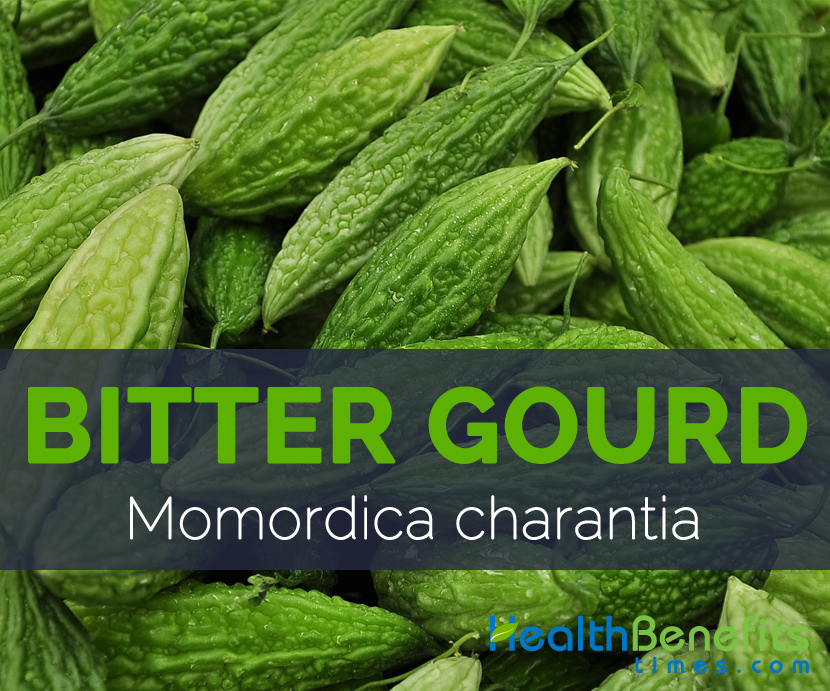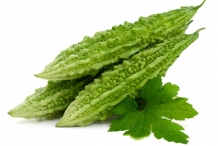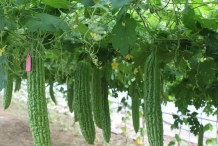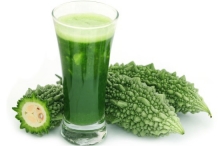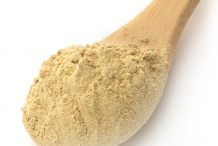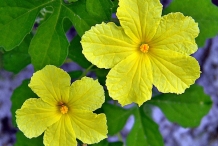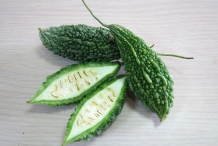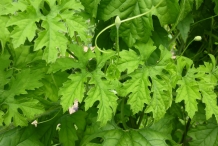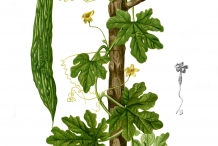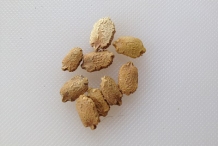| Bitter Gourd Quick Facts | ||
|---|---|---|
| Name: | Bitter Gourd | |
| Scientific Name: | Momordica charantia | |
| Origin | Originated in India and was introduced into China in | |
| Colors | Emerald green when young, turning to orange-yellow when ripe | |
| Shapes | Long-peduncled, obovoid or oblong-cylindric, coarsely ridged and bumpy-tuberculate, distinct warty exterior 7–30 cm | |
| Flesh colors | White | |
| Taste | Bitter | |
| Calories | 12 Kcal./cup | |
| Major nutrients | Vitamin C (22.78%) Vitamin B9 (8.00%) Zinc (4.36%) Potassium (4.21%) Dietary Fiber (3.16%) |
|
| Health benefits | Helpful in Diabetes, Fight head, neck cancer, Prevention of breast cancer, Fungal Infections, Hemorrhoid Relief, Immune System Health, Lowers Risk of Gout, Mental and Emotional Disorders, Eczema, Blood Pressure, Weight loss | |
| Proximity | Amount | % DV |
|---|---|---|
| Water | 58.25 g | N/D |
| Energy | 12 Kcal | N/D |
| Energy | 49 kJ | N/D |
| Protein | 0.52 g | 1.04% |
| Total Fat (lipid) | 0.11 g | 0.31% |
| Ash | 0.44 g | N/D |
| Carbohydrate | 2.68 g | 2.06% |
| Total dietary Fiber | 1.2 g | 3.16% |
| Total Sugars | 1.21 g | N/D |
| Minerals | Amount | % DV |
|---|---|---|
| Zinc, Zn | 0.48 mg | 4.36% |
| Potassium, K | 198 mg | 4.21% |
| Phosphorus, P | 22 mg | 3.14% |
| Iron, Fe | 0.24 mg | 3.00% |
| Magnesium, Mg | 10 mg | 2.38% |
| Manganese, Mn | 0.053 mg | 2.30% |
| Copper, Cu | 0.02 mg | 2.22% |
| Calcium, Ca | 6 mg | 0.60% |
| Sodium, Na | 4 mg | 0.27% |
| Selenium, Se | 0.1 µg | 0.18% |
| Vitamins | Amount | % DV |
|---|---|---|
| Vitamin C (Ascorbic acid) | 20.5 mg | 22.78% |
| Vitamin B9 (Folate, Folic acid) | 32 µg | 8.00% |
| Vitamin B1 (Thiamin) | 0.032 mg | 2.67% |
| Vitamin B2 (Riboflavin) | 0.033 mg | 2.54% |
| Vitamin K (phylloquinone) | 3 µg | 2.50% |
| Vitamin B5 (Pantothenic acid) | 0.12 mg | 2.40% |
| Vitamin B6 (Pyridoxine) | 0.025 mg | 1.92% |
| Choline | 6.7 mg | 1.22% |
| Vitamin B3 (Niacin) | 0.174 mg | 1.09% |
| Vitamin E (alpha-tocopherol) | 0.09 mg | 0.60% |
| Vitamin A | 4 µg | 0.57% |
| Beta Carotene | 42 µg | N/D |
| Lutein + zeaxanthin | 820 µg | N/D |
| Lipids | Amount | % DV |
|---|---|---|
| Fatty acids, total saturated | 0.009 g | 0.01% |
| Palmitic acid 16:00 (Hexadecanoic acid) | 0.006 g | N/D |
| Stearic acid 18:00 (Octadecanoic acid) | 0.002 g | N/D |
| Oleic acid 18:1 (octadecenoic acid) | 0.02 g | N/D |
| Linoleic acid 18:2 (octadecadienoic acid) | 0.048 g | N/D |
Health benefits of Bitter Gourd
Bitter gourd is loaded with essential nutrients, minerals and vitamins which are essential to live healthy life. It is found beneficial in diabetes, different cancers, fungal infections, hemorrhoids and many other diseases.
1. Helpful in Diabetes
Diabetes can be managed quite well by dietary changes, modest exercise, effective weight reduction, as well as natural supplements for example herbs, vitamins, amino acids, enzymes and minerals. Research concluded that a water-soluble extract of the fruit considerably decrease blood glucose concentrations during a 50-gram oral glucose tolerance test in the diabetics. Bitter melons might encourage the release of insulin when needed the most. It also relieves the dehydration that frequently accompanies diabetes.
2. Fight head, neck cancer
Research found that bitter melon extract, a vegetable frequently used in Indian and Chinese diets, decreases the head and neck cancer cell growth. Bitter melon extract treatment suppressed the head and neck cancer cell growth, reducing the growth of the tumor. Research also found that treatment with this natural substance stopped the breast and prostate cancer cell growth, finally stopping them from spreading.(1)
3. Fungal Infections
Antibacterial and antifungal features of bitter melon make it perfect for fighting off numerous fungal infections, and also assisting to rid the bloodstream of those toxins before they can do any more damage. Regarding to infections and skin health, bitter melon has been beneficial in handling psoriasis and ringworm. Additionally, its anti-inflammatory abilities decrease the irritating itching related with skin conditions and infections. The juice take out from the leaves can be the best salve or cure for these disorders, topically applied to the affected areas.(3)
4. Hemorrhoid Relief
Research concluded the anti-inflammatory qualities present in bitter melon make it a very good salve for the painful condition of piles, commonly known as hemorrhoids. Make a paste from the root of the bitter melon plant and apply it topically to decrease the inflammation and relieve pain and bleeding. By drinking bitter melon juice, you can also obtain similar benefits too!(4)
5. Immune System Health
Bitter melon is a source of many antioxidants which make it a powerful defense mechanism against illness in the body. Antioxidants scavenge the body for free radicals, hazardous compounds released throughout cell metabolism may cause any number of different illnesses. With the addition of bitter melon in your diet, you can significantly increase your chances of defending serious diseases, like kidney damage, liver failure and heart attack; three of the many places exactly where free radicals cause health issues.(5)
6. Prevention of breast cancer
Research conclude that Bitter melon extract, a common dietary supplement, exerts a significant effect against breast cancer cell growth and may finally become a chemopreventive agent against this form of cancer. Bitter melon extract moderates several signal transduction pathways, which induces breast cancer cell death. This extract can be used as a dietary supplement for the prevention of breast cancer.(2)
7. Lowers Risk of Gout
Bitter gourd is essential for lowering the risk of gout as it is loaded with Vitamin C. Gout is a painful condition where big toe becomes stiff, painful and inflamed because of extra uric acid leading to crystals formed in joints.
Research concludes that consuming vitamin C on a regular basis will help to reduce the chances of gout. It is also concluded that nearly 1500 mg of vitamin c per day have nearly half risk of getting gout. Consuming vitamin c rich food regularly is beneficial for Gout.
8. Mental and Emotional Disorders
Bitter gourd is supportive in treating numerous mental and emotional disorders. Anxiety and depression are two of the most common mental health problems which are cured with regular consumption of Vitamin B9 rich foods like Bitter gourd.
9. Eczema
Eczema also known as atopic dermatitis is actually an inflammatory and chronic disorder of the skin caused due to zinc deficiency. Zinc is important for healing chronic infections and helps body to restore its capability to heal completely and effectively. The irritation is cleared up by re-balancing the zinc content in your blood. So consume zinc rich bitter gourd regularly to be safe from eczema.
10. Blood Pressure
Normal blood pressure level is essential to remain healthy and bitter gourd helps us to normalize our blood pressure level. Potassium present in bitter gourd is helpful in reversing the role of sodium in unbalancing normal blood pressure. It is a main component that maintains normality of blood pressure in human. Apart from that it helps to decrease the chances of hypertension as well as heart diseases. Regulation of blood pressure is one of the most important functions of potassium due to its vasodilating properties which work to relieve the tension of blood vessels that is one of the main reasons of high blood pressure.
11. Weight loss
Apart from helping digestion and avoiding constipation, dietary fiber adds bulk to the diet that is a key factor for losing body weight and maintaining body weight. Adding bulk can help you feel full faster. As fiber remains for a longer time in the stomach than other foods, that feeling of fullness will stay with you much longer, helping you eat less. Fruits and vegetable are fiber rich foods and have low calorie, therefore adding fiber to your diet, it’s easier to cut calories.
https://www.youtube.com/watch?v=IrgBCQdTm6c
How to Eat
- Mature, unripe green fruits and young tender leafy shoots are eaten as vegetables.
- Bitter melon is often used in stir-fries (often with pork, chicken and douchi), soups, and or sliced and stuffed with minced pork or fish paste in China.
- Dried Bitter melon slices are used as herbal tea.
- Raw bitter melon slices are consumed with dried meat floss and stuffed to make bitter melon soup with shrimp or sliced and used with eggs in soup in Vietnam.
- Bitter melons stuffed with minced pork are served as a popular summer soup in the South.
- It is a noteworthy component of Okinawan cuisine and is deemed as its national vegetable and honored with a special festive day – Goya honoring day.
- Fermented bitter melon tea is popular in Okinawa.
- Bitter melon is enjoyed in numerous dishes in the Philippines.
- Fruit of the wild form is roasted over fire and consumed with either salt or“heko”.
- Cultivated form is eaten as a vegetable with shrimps or eggs, meat and diced tomatoes or as stir fries with minced beef.
- Sliced bitter melon is mixed with salt, washed and made into salads with sprinkling of shredded ‘tinapa ’, onions and vinegar.
- Popular dish from the Ilocos region of the Philippines, pinakbet, includes of bitter melons, okra, lima beans, eggplant, string beans, tomatoes and other various regional vegetables stewed with a little bagoong -based stock.
- Young shoots and leaves are consumed as greens in the Philippines.
- Bitter melon is used in stir fry, cooked in coconut milk, or steamed in Indonesia.
- Fruit is cut length-wise and the halves are stuffed with fried fish, meat or spices and then tied stuffing with sereh (Piper sarmentosum) leaves and stewing them.
- Bitter melon fruit is wrapped in trasi and wrapped in a banana leaf and roasted in the ashes.
- The fruit is also cut into pieces and boiled with lombok, coconut milk, onion and salt.
- Tender leaves and young fruits are eaten as lalab or sepan or as belem.
- Bitter melon is used in stir fries, soups, with chicken or beef slices and ginger, or stuffed with various types of minced meat in Malaysia.
- It is popularly used in curries in India.
- Bitter melon stuffed with spices and fried in oil is popular dish in Punjabi and Tamil cuisine.
- In Kerala it is used in a dish called thoran mixed with theeyal and pachadi.
- Bitter melon is used in a delicacy called gojju which tastes great with dosas and chapatis in Karnataka.
- Bitter melon achar is popular in Nepal, so is bitter melon curry on its own, or combined with potato, or as stuffed vegetables.
- Whole bitter melon is boiled unpeeled and stuffed with cooked ground beef and is served with hot tandoori bread, nan, chappati or with khichri in Pakistan.
- Sliced bitter melon is normally cooked with lots of onion.
- Bitter melon is sautéed with garlic, onion and scotch bonnet pepper in Trinidad and Tobago.
Other Traditional uses and benefits of Bitter Gourd
- Almost all parts of the plant are used in traditional medicine.
- Plant is traditionally used as anti-diabetic, anthelminitic, antibacterial, anti-tumor and also used in liver disorders.
- Whole plant along with other medicinal herbs is used for snake-bites in Senegal.
- Plant is used as a laxative, for stomachache, a taenifuge and anthelmintic, and to treat fevers in West Africa.
- Plant is used as taenifuge especially in children in Congo.
- Plant is used with other medicinal plants and processed into an ointment for skin affections like scabies, psoriasis and other diseases in India and Japan.
- Fruit is used as a bitter stomachic and a purgative in Nigeria.
- Bitter melon fruit is used to treat gastrointestinal diseases, and extracts have shown activity in-vitro against the nematode worm, Caenorhabditis elegans in Togo.
- Fruit is used as an appetite stimulant and as a treatment for gastrointestinal infection and against breast cancer in traditional Chinese medicine.
- Bitter gourd fruit is regarded as good for dysentery, liver diseases, sunstroke, inflamed eyes tonic and purgative in China.
- Bitter melon is traditionally regarded useful for preventing and treating malaria by Asians, Panamanians and Colombians.
- Fruit have medicinal properties along with potential for decreasing diabetes mellitus.
- Fruit is considered tonic and stomachic, and is useful in rheumatism and gout and in diseases of the spleen and liver.
- Fruit is considered a remedy for catarrh, fluxes, and children’s coughs.
- Juice from the green fruit is used for chronic colitis in Philippines.
- Seeds are used as anthelmintic in Brazil and for round worms in Zaire.
- Leaves are used as external application in different skin aliments, leprosy, burns and scalds and as poultice for headaches.
- Sap of the leaves is used as a parasiticide, and when softened in oil, is employed as a vulnerary.
- It is good for bacillary dysentery.
- Juice of the fresh leaves acts as a mild purgative for kids.
- Pounded leaves are applied to the body for scalds, burns, skin diseases and to the abdomen of children for stomach-ache in Malaysia and India.
- Leaf infusion is drunk for headache.
- Leaf juice is taken as vermifuge for children or gargle for sprue; leaf poultice for headache and flowers used in an infusion for asthma in Malaysia.
- Leaf juice is taken for bilious complaints in India.
- Leaves are used as febrifuge; a plaster of crushed leaves is used as plaster for skin parasites like filarial and Guinea-worm, and for menstrual problems in Senegal.
- The root is sometimes used as an ingredient in aphrodisiac prescriptions and fruit or seeds, is also used as an abortifacient, as well as a remedy for urethral discharges and is used externally to hemorrhoids.
- Vine is used for diabetes and urinary complaints in the West Indies.
- Roots are used for treating syphilis, rheumatism and yaws in Senegal.
Other Facts
- Leaves are used to clean metals.
- Leaves contain cucurbitane glucosides which are toxic to certain insects and can be used as insecticides.
Precautions
- Bitter melon is contraindicated in pregnant women since it can encourage bleeding, contractions, and miscarriage.
- Bitter melon may cause allergic reactions in people with allergy or hypersensitivity to members of the Cucurbitaceae family.
- Plant has been documented to reduce fertility in both males and females and should therefore not be used by those undergoing fertility treatment or seeking pregnancy.
- People suffering from hypoglycemia must not consume bitter melon as it might make their condition worse.
- Bitter melon lowers the level of blood glucose, it can cause coma in those vulnerable to hypoglycemia.
Bitter Gourd Facts
Bitter gourd also known as bitter melon, African cucumber is a herbaceous, slender perennial plant found growing in light–textured, free draining, and loamy soils rich in organic matter. Apart from its bitter taste it is full of important nutrients, minerals and vitamins.
| Name | Bitter Gourd |
|---|---|
| Scientific Name | Momordica charantia |
| Native | Originated in India and was introduced into China. |
| Common/English Name | Tuberculated Momordica , Bitter Gourd, African Cucumber, Carilla Gourd, Leprosy Gourd, Balsam-Apple, Balsam Pear, Balsam Pear, Bitter Melon, Bitter Momordica, Bitter Cucumber, Cerasee, La-Kwa (USA), Leprosy Pear, Squirting Cucumber, Alligator Pear |
| Name in Other Languages | Turkish : Kudret Narı Bahamas : Wild Balam Pear Japanese : Gōyā ( Okinawa ), Ki-Uri, Niga Uri India : Karalla ( Assamese), Kôrolla ( Bengali) Guinea-Bissau : Sancaetano ( Crioulo ), Burbóqui Iran : Sinahang Dutch : Balsempeer, Sopropo Ghana : Nya-Nya ( Akan-Asante ), Nya-Nya( Fante ) Spanish : Achoccha Silvestre, Achocha China Burmese : Kyethinkhathee Chinese : Fu Kwa, Foo Gwa, Foo Kwa, Ku Gua Finnish : Karvaskurkku Hungarian : Balzsamkörte, Balzsamuborka Indonesia : Pare, Pare Alas ( Javanese) , Pari Brazil : Melão-De-São-Caetano, Melãozinho Korean : Yôju Danish : Agurkagtig Balsamæble, Balsamaeble Fiji : Armagosa, Karela, Poiyoi, Naere Polish : Przepękla Ogórkowata Taiwan : Kǔguā Sri Lanka : Karawila ( Sinhalese ) Portuguese : Melão-De-São-Caetano Liberia : Gã Gĕ Su Lu ( Mano ) Italian : Balsamini Lunghi, Pomo Meraviglia Ivory Coast : Acoatiango ( Abure ), Sing Biep( Adyukru ) German : Balsambirne, Balsamgurke Jamaica : Cerasee German : Balsambirne, Bittergurke Mali : Lumba-Lumba ( Songhai ), Manamat( Tamachek ) Persian : Komboze Kampuchea : Mreah Tonga : Meleni ‘Ae Kuma, Vaine ‘Initia Philippines : Marigoso, Paria ( Bikol ), Palia( Bontok Singapore : Kor Kuey ( Hokkien ) Arabic : Hanzal Chamorro : Almagosa, Atmagoso, Atmagosu Swedish : Bittergurka Tobago : Caraili West Indies : Balsam Pear, Carilla, Kuguazi Laos : Bai Mak Phak Sai, Bai Maha, Haix Malaysia : Peria, Peria Laut, Periok Mauritius Islands : Margose Haiti : Asosi ( Creole ) Puerto Rico : Cun De Amor, Machete Sierra Leone : Sapodila ( Krio ), Kuru-Kurinyi ( Susu ) Nepal : Karelaa, Tito Karela Nigeria : Ndakđì ( Dera ), Dagdaggi, Habiiru, Lele Duji (Fula-Fulfulde) Senegal : Beurbŏh ( Fula-Tukulor ), Zara( Manding-Bambara ) Norwegian : Balsamfrukt, Bitter Gord Pakistan : Karelā ( Urdu ) Cook Island : Menemene, Pō Kutekute Slovašcina : Momordika Palau : Markoso Trinidad & Tobago : Karailī ( Hindu ), Caraili Panama : Balsamino French : Concombre Africain, Concombre Amer Thai : Maha, Mara, Marajin, Phakha Réunion : Margose ( French ) Vietnamese : Khổ Qua ( Southern ), Mướp Ðắng( Northern ) |
| Plant Growth Habit | Herbaceous, slender perennial, climber |
| Growing Climate | Tropical and subtropical regions with warm, sunny planting location |
| Soil | Light–textured, free draining, and loamy soils rich in organic matter. Water-logged soils should be avoided. |
| Life Span | 1 year |
| Plant Size | 5 m (16 ft.) in length |
| Root | Central taproot |
| Stem | Stem is slender, slightly pubescent, grooved and light green. It branches at the base. |
| Leaf | Alternate, suborbicular or broadly reniform in outline, 10–12 cm long, 5–8 cm wide |
| Flowering Season | June to July |
| Flower | Axillary, solitary, unisexual to monoecious, yellow on long, slender peduncle bearing a foliaceous |
| Fruit shape & size | Fruit long-peduncled, obovoid or oblong-cylindric, coarsely ridged and bumpy-tuberculate, distinct warty exterior 7–30 cm |
| Fruit color | Emerald green when young, turning to orange-yellow when ripe |
| Flesh color | White |
| Fruit Taste | Bitter |
| Seed | Seeds are oval elliptic, almost toothed at the top, 10 to 16 mm long and 7-9 mm wide and 2-3 mm thick, covered by a red mucilage. white in raw fruits and red when they are ripe |
| Varieties/Types | White Bitter melons , Hybrid Nanha, Green Lover, India Long White, Hybrid White Pearl, Japan Green Spindle, Hybrid White Vivek, Hong Kong Green, Hybrid Baby Doll, Hybrid Extra Jumbo, Hybrid India Baby, Hybrid India Green Queen, Hybrid Nayan Long, Hybrid Green Giant, Small Baby TH, Taiwan Large, Japan Long, Hybrid Best Champion, Hybrid Beauty Winner, Hybrid Aman Green, Hybrid Taiwan White, Hybrid India Pearl, Hybrid Jumbo Choice, Large Top, Southern Money Maker, India Long Green |
| Season | September to November. |
| Major Nutrition | Vitamin C (Ascorbic acid) 20.5 mg (22.78%) Vitamin B9 (Folate, Folic acid) 32 µg (8.00%) Zinc, Zn 0.48 mg (4.36%) Potassium, K 198 mg (4.21%) Total dietary Fiber 1.2 g (3.16%) Phosphorus, P 22 mg (3.14%) Iron, Fe 0.24 mg (3.00%) Vitamin B1 (Thiamin) 0.032 mg (2.67%) Vitamin B2 (Riboflavin) 0.033 mg (2.54%) Vitamin K (phylloquinone) 3 µg (2.50%) |
| Health Benefits |
|
| Calories in 1cup (145gm) | 12 Kcal |
References
http://www.ncbi.nlm.nih.gov/pmc/articles/PMC4027280/
https://en.wikipedia.org/wiki/Momordica_charantia


